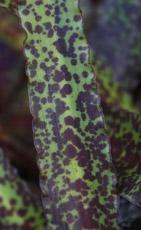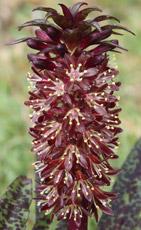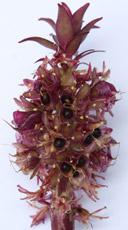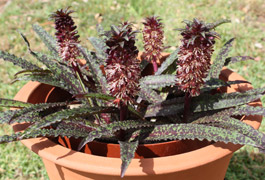Eucomis vandermerwei
Eucomis vandermerwei I.Verd.
Family: Hyacinthaceae
Common names: spotted-leaf eucomis
Introduction
Eucomis vandermerwei is a threatened alpine bulb with unusual maroon, fetid flowers and dark green leaves with deep maroon markings and strongly wavy margins. It is an interesting and long-lasting summer-flowering container subject or rock garden plant.

Description
Description
This summer-growing, winter-dormant geophyte (a plant with subterranean buds produced on specialized storage organs) is a dwarf species reaching 80-200 mm high. It grows from an ovoid (egg-shaped) bulb and has perennial fleshy roots. The 3-6 linear leaves are produced in a rosette and have dark green upper and lower surfaces that are heavily spotted or blotched with deep maroon, and cartilaginous (hard) wavy margins.

The light green peduncle (flower stem) grows 60-120 mm high and is heavily blotched with deep maroon. The inflorescence is a short raceme (the flowers are stalked and borne along an elongated axis) of long-lasting maroon, foetid blooms with white to light green filaments and ovaries. Overtopping the inflorescence is a small head of leaf-like, dark green bracts with maroon markings.

The brownish-maroon seed capsules produce relatively large, ovoid, black seeds with a glossy testa (outer coat). Flowering occurs in summer, from December to February.

Conservation Status
Status
Eucomis vandermerwei is a protected species. It is also a threatened species and its conservation status is Vulnerable. It is currently known from only six to eight populations in the wild and is under threat from habitat loss due to expanding forest plantations, overgrazing and trampling by livestock, harvesting of bulbs by local tribes for medicinal purposes, and smothering by invasive alien plants. Coal mining is another potential additional threat. Rock hyraxes and rodents feed on the bulbs in winter, and seed mortality is high as the seed capsules are heavily parasitized by insects.
Distribution and habitat
Distribution description
Eucomis vandermerwei occurs from Middelburg to Dullstroom and the Steenkampsberg in western Mpumalanga in the far north-eastern part of South Africa. It is a narrow endemic of high altitude summit hill slopes and plateaux from 2200-2500 m. Its niche is well-drained, sandy soil amongst quartzitic stones and between crevices of quartzitic rocky ledges and in short grass tufts, mainly on south- and east-facing slopes. The soil pH is acid, recorded as 4.3. The plants are found in small groups within localised colonies, rarely as solitary individuals, within the Grassland Biome, in Lydenburg Montane Grassland vegetation. The area is subject to high summer rainfall and frequent summer mists, frost in late autumn and winter, and dry winters.
Derivation of name and historical aspects
History
Eucomis vandermerwei was collected for the first time in March 1937 by the amateur botanist Dr Frederick Ziervogel van der Merwe (1894-1968) in the Middelburg District of western Mpumalanga. The species was described by the Pretoria botanist Dr Inez Verdoorn in The Flowering Plants of South Africa, accompanied by a lithograph by Ethel Burgess, hand-coloured by A.W. Darnell.
The generic epithet Eucomis is derived from the Greek eu and komos, meaning `beautifully haired', alluding to the beautiful or prominent head or `coma' of leaf-like bracts that overtop the inflorescence, like those of the pineapple. The flowers of E. vandermerwei are similarly shaped to those of the dwarf E. zambesiaca but the latter has white tepals and occurs in northern Limpopo, Zimbabwe and Malawi.
Eucomis contains 12 species and is distributed mainly in the summer rainfall eastern and northern parts of South Africa, extending north to Malawi in east Central Africa. The only winter-growing member is the dwarf E. regia, a native of rocky outcrops from Namaqualand in the Northern Cape to Bredasdorp in the southern Cape.
Ecology
Ecology
Eucomis vandermerwei is the only eucomis with cryptic leaf colouration. The maroon-spotted leaves provide camouflage in reducing herbivore damage by merging with surrounding rocks and short grass cover. The strongly foetid flowers are probably pollinated by carrion flies although this has not yet been confirmed by actual sightings. Occurring in an area often subject to sub-zero winter temperatures, the bulbs survive these conditions by shedding all their above-ground parts in late autumn and remaining dormant throughout winter. Winter grass fires have a highly beneficial effect on flowering performance, the best floral displays being produced in the summer immediately following intense fires that clear thick grass cover. The peduncle (flower stem) remains attached to the bulb for several months after flowering and when ripe, the inflated seed capsules split from the top downwards and the seeds are shed locally by the shaking action of wind.
Uses
Use
The bulbs are used to a limited extent in ornamental horticulture as container and rock garden subjects. They are also sometimes harvested by local tribes for medicinal purposes.

Growing Eucomis vandermerwei
Grow
Eucomis vandermerwei is popular amongst growers of alpine bulbs and by rock garden enthusiasts, and it is more often grown in specialist collections abroad than in its native South Africa. The plant is very well suited to pots or bowls due to its dwarf habit and striking, long-lasting brownish-maroon racemes; its cryptically maroon-spotted leaves with wavy margins make it worth growing for these features alone. It requires full morning sun and afternoon shade, or bright light throughout the day. The plants flower reliably every year in ideal conditions, and remain attractive even during the fruiting stage. They can be grown in the cool greenhouse, on a patio or window sill or plunged into rock garden pockets in summer, or even planted into permanent well-drained raised beds. The bulbs are hardy down to - 5 °C but cannot survive excessive moisture in winter and have to be stored as dry as possible during this period. Like the dwarf E. schijffii, the only drawback this species has as a container subject is its foetid scent, but this is only evident at close quarters.
Bulbs of E. vandermerwei are planted shallow (about 10 mm deep) in early summer and perform best in a well-drained, acid sandy medium such as equal parts of coarse river sand and finely sifted, acid compost. At Kirstenbosch 250 mm diam. plastic pots have produced excellent results but in cold climates, smaller terracotta containers may be preferable. After an initial heavy drench in early summer, it is best to wait for the leaves to appear, then drench weekly until the leaves start to turn yellow in autumn. As with all Eucomis species, this plant responds very well to organic fertilizers with a high potassium, low nitrogen content.
Propagation is achieved by seed, offsets, bulb slicing, leaf cuttings and tissue culture. Sow the seeds 3-4 mm deep in early summer, in the same medium recommended for adult bulbs, and water regularly with a fine rose. Germination of fresh seeds takes place within 3-4 weeks and flowers can be expected in the fourth year. It is necessary to isolate and cross-pollinate flowers to obtain pure seeds, but despite these measures, seed production in this plant is not prolific. The bulbs multiply well by offset formation but these should be allowed to increase in size for about two years before removal, to prevent excessive damage to the basal plates. Bulb slicing entails cutting mature bulbs into longitudinal sections, each containing a portion of the basal plate. The cut sections are treated with a fungicide and placed upright, with the tips exposed, in a slightly moist rooting medium such as equal parts of river sand or grit and peat moss. After a few weeks young bulblets will begin to form on the cut surfaces of the basal plate and these are removed at the beginning of the next growing season and potted-up individually.
To take a leaf cutting, remove a leaf by holding it firmly at the base and pulling it off with a swift tug, or alternatively, twist it off at the base. Depending on size, cut the leaf material into two or more cross sections up to 100 mm long with a sharp knife, and place in a well-drained rooting medium such as equal parts riversand and vermiculite or finely milled bark, with the base of the cutting inserted 10-15 mm below the surface, and place in a warm and dry, shady spot. Keep the medium just slightly moist, not continually wet, as excessive moisture will soon lead to basal rotting. The cutting taken from the base of the leaf often produces the best results as the tissue in this portion is harder and less prone to rot. At the end of the growing season, lift the withered cutting and remove the bulblets, then store and pot them up in the normal way. Bulblets can also be obtained in about 3 weeks from the cut surface of basal leaf cuttings placed in a container of shallow water. This species can also be propagated by tissue culture, but this method is beyond the scope of the home gardener as it has to be performed under laboratory conditions.
Eucomis vandermerwei is generally pest- and disease-free, but mealy bugs sometimes infest the bulb tunics and leaf bases, and can lead to viral infection.
References
- Craib, C.L. & Brown, L. 1998. The ecology of Eucomis vandermerwei on the Steenkampsberg in South Africa's Mpumalanga Province. Herbertia 53: 152-155.
- Crouch, N.R. & Krynauw, S. 1999. The high altitude pineapple lily Eucomis vandermerwei, a rare endemic from South Africa. Herbertia 54: 133-138.
- Duncan, G.D. 2007. Lesser-known eucomis. The Plantsman (New Series) 6: 98-103.
- Duncan, G.D. 2010. Grow bulbs. Kirstenbosch Gardening Series. South African National Biodiversity Institute, Cape Town.
- Duncan, G.D. 2011. Eucomis vandermerwei. Curtis's Botanical Magazine 28: 176-189.
- Lötter, M., Burrows, J.E. & Von Staden, L. 2009. Eucomis vandermerwei. In: Raimondo, D., Von Staden, L., Foden, W., Victor, J.E., Helme, N.A., Turner, R.C., Kamundi, D.A. & Manyama, P.A. (eds). Red List of South African plants 2009. Strelitzia 25, pp. 115-116. South African National Biodiversity Institute, Pretoria.
- McCartan, S.A., Crouch, N.R. & Krynauw, S. 1999. Micropropagation of a naturally rare pineapple lily, Eucomis vandermerwei I.Verd. Journal of the Southern African Society for Horticultural Sciences 9: 33-35.
- Mucina, L. & Rutherford, M.C. 2006. The Vegetation of South Africa, Lesotho and Swaziland. Strelitzia 19. South African National Biodiversity Institute, Pretoria.
- Verdoorn, I.C. 1944. Eucomis vandermerwei. The Flowering Plants of South Africa 24: t. 955.
- Zonneveld, B.J.M. & Duncan, G.D. 2010. Genome sizes of Eucomis L'Hér. (Hyacinthaceae) and a description of the new species Eucomis grimshawii.. Plant Systematics and Evolution 284: 99-109.
Credits
Graham Duncan
Kirstenbosch National Botanical Garden
May 2012
Plant Attributes:
Plant Type: Carnivorous
SA Distribution: Mpumalanga
Soil type: Sandy, Loam
Flowering season: Late Summer
PH: Acid, Neutral
Flower colour: Brown, Red
Aspect: Morning Sun (Semi Shade)
Gardening skill: Easy
Special Features:
Horticultural zones











Rate this article
Article well written and informative
Rate this plant
Is this an interesting plant?
Login to add your Comment
Back to topNot registered yet? Click here to register.